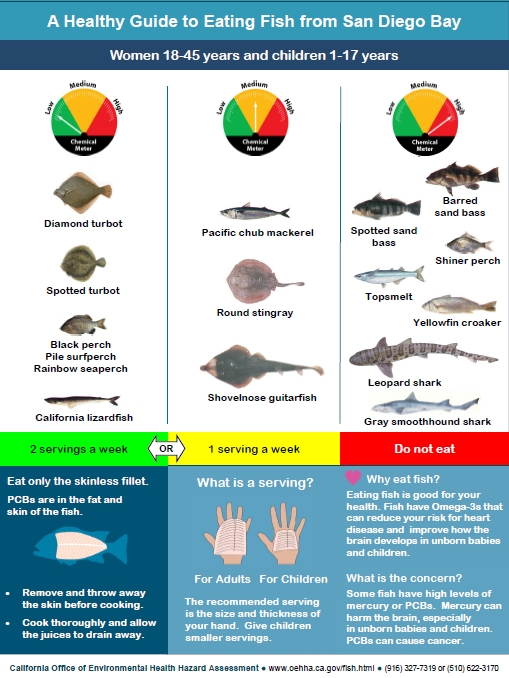San Diego: Four Elasmobranch Species mentioned in New Fish Consumption Advisories
Press Release
Office of Environmental Health Hazard Assessment (OEHHA)
Sam Delson
22. October 2013
———————–
New State Fish Consumption Advisories For San Diego Bay and Mission Bay:
Mercury and PCBs are the chemicals of potential concern
SACRAMENTO – Anglers should avoid eating shiner perch and topsmelt from San Diego Bay but can safely eat two servings per week of diamond or spotted turbot, three perch species, or lizardfish, according to a new state fish advisory.
The guidelines for 16 fish species in San Diego Bay and an accompanying advisory for 12 species in nearby Mission Bay were released today by the California Environmental Protection Agency’s Office of Environmental Health Hazard Assessment (OEHHA).
The recommendations for Mission Bay are less restrictive than for San Diego Bay, with no fish species listed in the “do not eat” category. However, children under 18 and women up to age 45 should limit consumption of spotted sand bass and brown smoothhound shark from Mission Bay to no more than one serving per week. They can safely eat at least six servings per week of diamond turbot, spotted turbot, opaleye, or topsmelt from Mission Bay.
“These advisories are intended to help anglers and their families safely choose fish to eat from San Diego Bay and Mission Bay,” said OEHHA Director Dr. George Alexeeff. “Fish are an excellent source of protein and can help reduce the risk of heart disease. These guidelines balance these health benefits against the risks from exposure to contaminants.”
The recommendations are based on the levels of methylmercury and PCBs in different fish species in the two bodies of water. Pesticides were detected in fish from both bays, but the levels of pesticides were lower than would be expected to cause health concerns.
Methylmercury can harm the brain and nervous system of people, especially in fetuses and children as they grow. PCBs affect many body functions, including effects on the nervous system, and can cause cancer and other health effects.
Mission Bay is part of the City of San Diego’s Mission Bay Park. Its area of more than 4,000 acres makes it the largest man-made aquatic park in the country. San Diego Bay is a natural harbor and is one of California’s major ports.
The guidelines for fish from San Diego Bay recommend that all anglers avoid eating shiner perch and topsmelt. Children and women of childbearing age should also avoid eating any barred sand bass, spotted sand bass, yellowfin croaker, leopard shark, and gray smoothhound shark from San Diego Bay.
All anglers can safely eat up to two servings per week of diamond turbot, spotted turbot, black perch, pile surfperch, rainbow surfperch, or California lizardfish from San Diego Bay. Women over 45 and men over 17 can safely eat two servings per week of round stingray or shovelnose guitarfish from the bay. Alternatively, all anglers can safely eat one serving per week of Pacific chub mackerel from San Diego Bay.
For Mission Bay, the guidelines recommend that children and women of childbearing age limit consumption of spotted sand bass or brown smoothhound shark to one serving per week or consume no more than two servings per week of yellowfin croaker. Women over 45 and men over 17 can safely eat up to three servings per week of these species or shiner perch. All anglers can safely eat up to three servings a week of striped mullet.
Children and women of childbearing age can safely eat at least six servings per week of diamond turbot, spotted turbot, opaleye, or topsmelt from Mission Bay. Women over 45 and men over 17 can safely eat up to seven servings per week of these species, or black perch, white seaperch, or rainbow seaperch.
The two San Diego County fish advisories are based on data from the Coastal Fish Contamination Program and the State Water Resources Control Board’s Surface Water Ambient Monitoring Program.
Fact sheets and the health advisories and guidelines for Mission Bay and San Diego Bay – as well as advisories and eating guidelines for other fish species and California bodies of water – are available at http://www.oehha.ca.gov/fish/so_cal/index.html.
OEHHA is the primary state entity for the assessment of risks posed by chemical contaminants in the environment. Its mission is to protect and enhance public health and the environment by scientific evaluation of risks posed by hazardous substances.
Source: OEHHA

